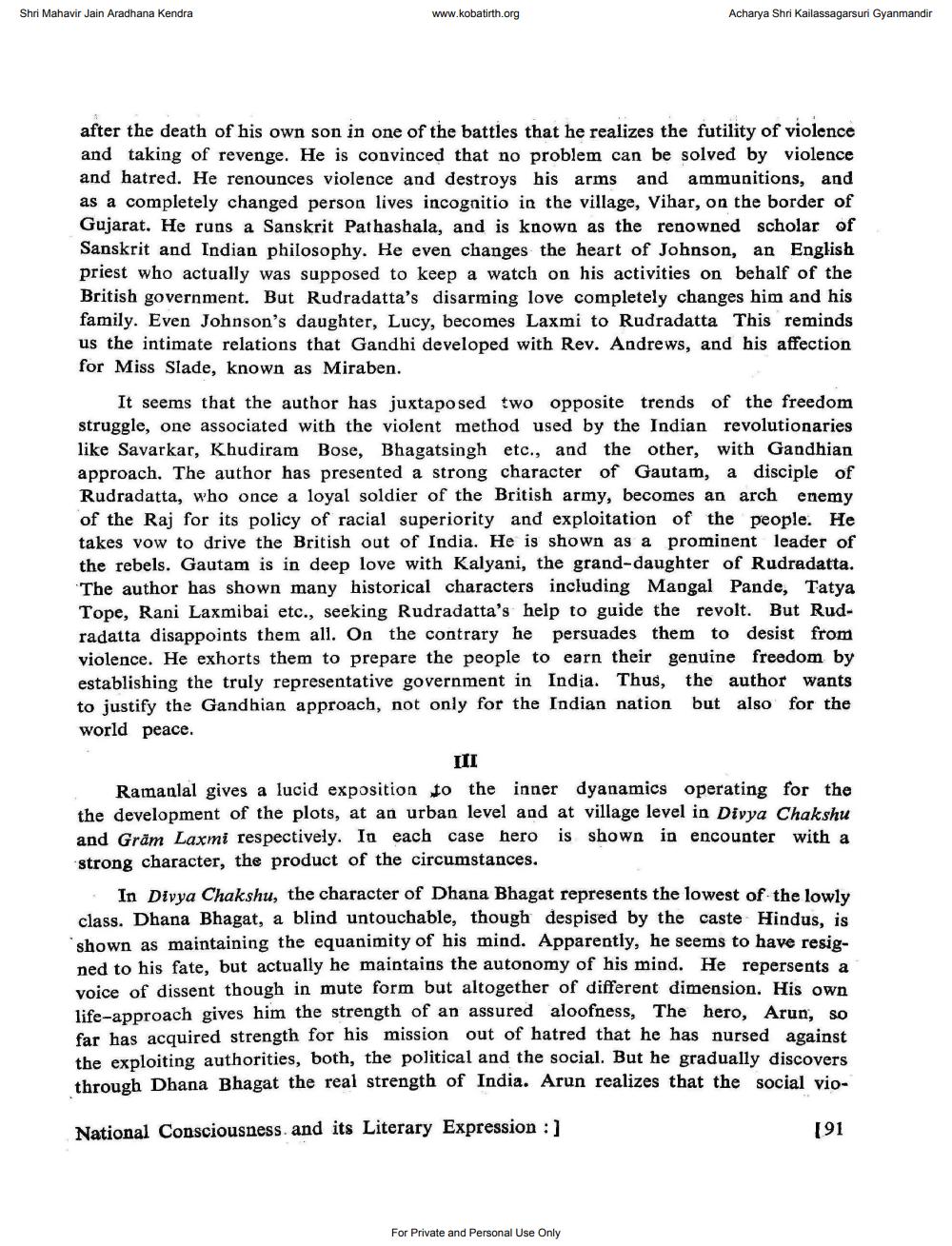________________
Shri Mahavir Jain Aradhana Kendra
www.kobatirth.org
Acharya Shri Kailassagarsuri Gyanmandir
after the death of his own son in one of the battles that he realizes the futility of violence and taking of revenge. He is convinced that no problem can be solved by violence and hatred. He renounces violence and destroys his arms and ammunitions, and as a completely changed person lives incognitio in the village, Vihar, on the border of Gujarat. He runs a Sanskrit Pathashala, and is known as the renowned scholar of Sanskrit and Indian philosophy. He even changes the heart of Johnson, an English priest who actually was supposed to keep a watch on his activities on behalf of the British government. But Rudradatta's disarming love completely changes him and his family. Even Johnson's daughter, Lucy, becomes Laxmi to Rudradatta This reminds us the intimate relations that Gandhi developed with Rev. Andrews, and his affection for Miss Slade, known as Miraben.
It seems that the author has juxtaposed two opposite trends of the freedom struggle, one associated with the violent method used by the Indian revolutionaries like Savarkar, Khudiram Bose, Bhagatsingh etc., and the other, with Gandhian approach. The author has presented a strong character of Gautam, a disciple of Rudradatta, who once a loyal soldier of the British army, becomes an arch enemy of the Raj for its policy of racial superiority and exploitation of the people. He takes vow to drive the British out of India. He is shown as a prominent leader of the rebels. Gautam is in deep love with Kalyani, the grand-daughter of Rudradatta. The author has shown many historical characters including Mangal Pande, Tatya Tope, Rani Laxmibai etc., seeking Rudradatta's help to guide the revolt. But Rudradatta disappoints them all. On the contrary he persuades them to desist from violence. He exhorts them to prepare the people to earn their genuine freedom by establishing the truly representative government in India. Thus, the author wants to justify the Gandhian approach, not only for the Indian nation but also for the world peace.
III
Ramanlal gives a lucid exposition to the inner dyanamics operating for the the development of the plots, at an urban level and at village level in Divya Chakshu and Gram Laxmi respectively. In each case hero is shown in encounter with a strong character, the product of the circumstances.
In Divya Chakshu, the character of Dhana Bhagat represents the lowest of the lowly class. Dhana Bhagat, a blind untouchable, though despised by the caste Hindus, is shown as maintaining the equanimity of his mind. Apparently, he seems to have resig ned to his fate, but actually he maintains the autonomy of his mind. He repersents a voice of dissent though in mute form but altogether of different dimension. His own life-approach gives him the strength of an assured aloofness, The hero, Arun, so far has acquired strength for his mission out of hatred that he has nursed against the exploiting authorities, both, the political and the social. But he gradually discovers through Dhana Bhagat the real strength of India. Arun realizes that the social vio
National Consciousness and its Literary Expression:]
[91
For Private and Personal Use Only




